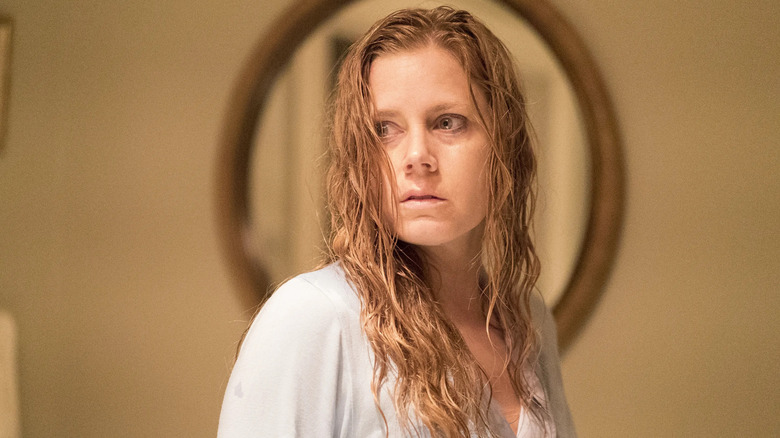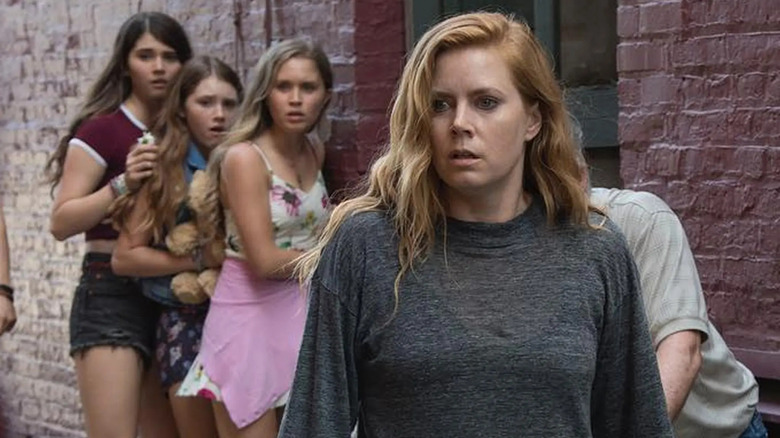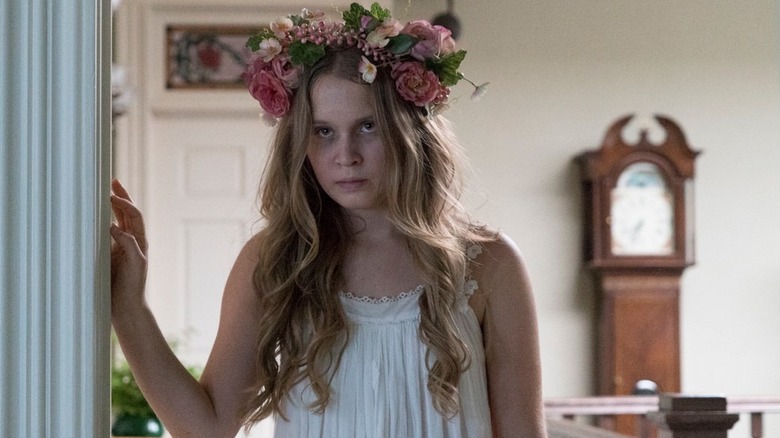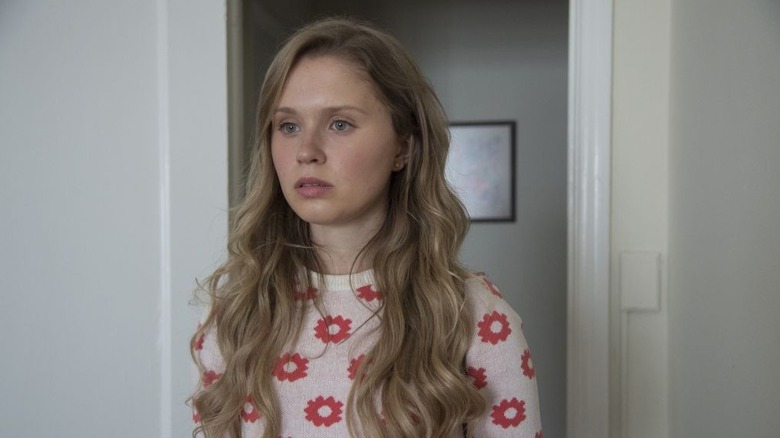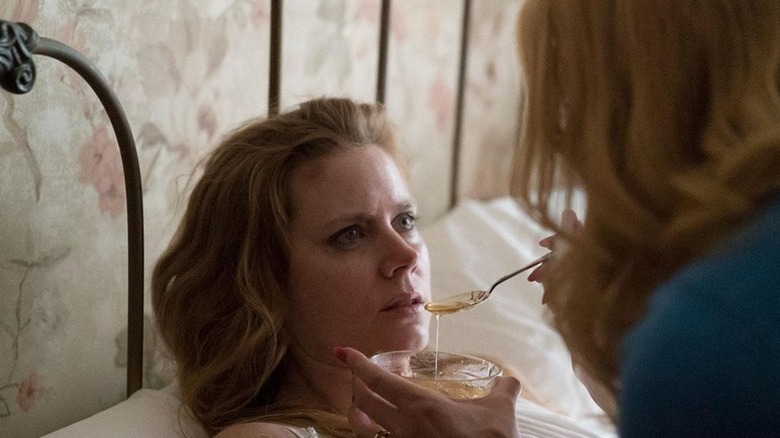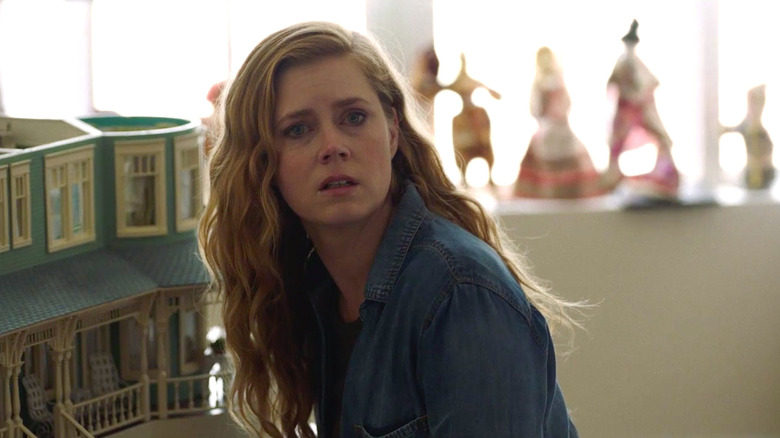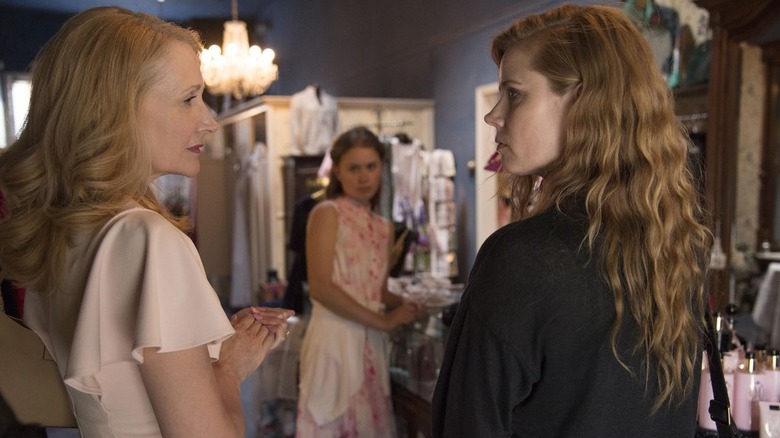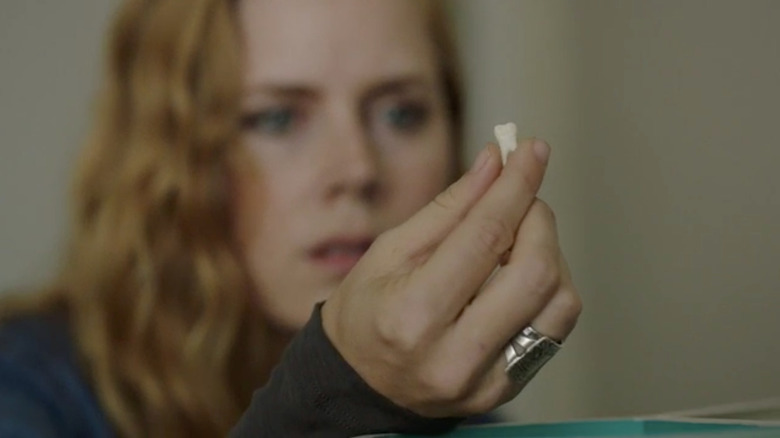Sharp Objects Ending Explained: The Truth Hurts
We may receive a commission on purchases made from links.
This article contains discussions of addiction, child abuse, and mental health.
HBO's 2018 miniseries "Sharp Objects," which is based on Gillian Flynn's 2006 debut novel of the same name, has an unforgettable ending — but what does it all mean? What does this story of generational trauma, violence, and abuse want its audience to understand, and, in terms of the narrative's central mystery, who's killing young girls and removing their teeth in the small town of Wind Gap, Missouri?
Let's back up before we get to all that. The television adaptation of "Sharp Objects" was overseen by "Buffy the Vampire Slayer" and "UnREAL" veteran Marti Noxon, who served as the series' showrunner, alongside the late visionary Jean-Marc Vallée, who also worked on the HBO series "Big Little Lies" and Reese Witherspoon's film "Wild." (Vallée passed away in 2021.) Led by Amy Adams as the protagonist Camille Preaker (in one of her best-ever roles), the show features incredible performances from Patricia Clarkson (as Camille's sinister Southern Belle mother, Adora Crellin), Eliza Scanlon (Camille's half-sister Amma), Chris Messina (Adams' "Julie & Julia" co-star, who appears as Detective Richard Willis in the series), and Elizabeth Perkins (as Adora's long-time friend and town gossip Jackie O'Neill), just to name a few.
"Sharp Objects" never shies away from the darkest, most reprehensible acts humans are capable of committing, culminating in a truly stomach-turning ending that was, honestly, foreshadowed all along. Here's everything you need to know about the conclusion of "Sharp Objects."
What you need to remember about Sharp Objects
The story of "Sharp Objects" begins in earnest when Camille Preaker, a journalist living in St. Louis — though, in Gillian Flynn's novel, she lives in Chicago — returns home to Wind Gap at the urging of her boss Frank Curry (Miguel Sandoval) to investigate some particularly grisly crimes. One Wind Gap girl, Ann Nash (Kaegan Baron), is already dead and was found in the town's nearby woods the summer before Camille even arrives. Now, another girl around the same age, Natalie Keene (Jessica Treska), is missing. Tragically, Natalie does reappear during the show's very first episode, "Vanish," when her dead body is propped up just behind Wind Gap's police station ... and the body is missing most of its teeth.
Wind Gap's police chief Bill Vickery (Matt Craven) and Detective Richard Willis — the latter of whom works in Kansas City and has been called in to help with the investigation — line up a number of suspects, including Natalie's brother John (Taylor John Smith) and Ann's father Bob (Will Chase), but nothing clicks into place right away. Camille, who aligns herself with Richard to get closer to the investigation, also navigates the antiquated town and her thorny relationship with her family — specifically, Camille and Adora's relationship has always been strained, particularly because Camille's other half-sister Marian (Lulu Nelson) died when they were both younger.
Through it all, Camille struggles with alcohol addiction and mental health issues that cause her to self-harm (specifically, she carves words into her body) and even strikes up an ill-advised dalliance with Richard. As Camille continues to fall apart, though, answers begin to rise to the surface.
What happens at the end of Sharp Objects, and is Amma the killer?
In the series' penultimate episode, "Falling," two enormously consequential things happen. First, Camille drunkenly hooks up with John, only for the police to arrest him for the murders of both Ann and Natalie, largely because some of Natalie's blood was found at his girlfriend Ashley Wheeler's (Madison Davenport) carriage house, where John was known to spend time. (During the arrest, Richard ends his fledgling relationship with Camille, seemingly leaving her to fend for herself.) Second, Camille learns, from a conversation with Jackie, that Marian died because Adora was poisoning her; Adora has Munchausen syndrome by proxy, meaning that she poisons her daughters so that they remain dependent on her (and to elicit sympathy from those around her for having "sick" children). As Camille rushes home to save Amma (who she now realizes has been drinking Adora's poisoned concoctions at the Crellin house the entire time she's been there), the series finale, "Milk," begins.
Camille pretends to be sick so that Adora will start feeding her "medicine" — which we'll circle back to later — and Amma has clearly already taken quite a bit, but before Adora can kill Camille with what turns out to be rat poison, Richard, Curry, and the police come to the door (Camille calls Curry in tears at the end of "Falling," tipping him off about Marian's death) and arrest Adora. When an officer finds pliers in the Crellin house covered in blood that match both Natalie and Ann, Adora ends up going to prison for multiple murders, Camille recovers in the hospital and receives an apology from Richard, and Amma moves to St. Louis (again, Chicago in the book) to live with Camille.
The story isn't quite finished, though. In St. Louis, Amma and Camille lead what seems to be a pretty peaceful life. Amma even makes friends with Mae (Iyana Halley), a girl who lives in Camille's building with her mother. That is, until, one day, Camille inspects Amma's dollhouse, which is one of the only reminders the two brought from Wind Gap. Upon looking closer, Camille finds a human tooth hidden within it, only to realize a floor of the dollhouse is inlaid with teeth ... at which point Amma appears in the doorway and simply says, "Don't tell Mama."
So, there you have it: Amma killed not just Mae but also Natalie and Ann. In brief flashes during the episode's credits, we see her friends Jodes and Kelsey (April and Violet Brinson) even helping her strangle Ann in the woods and Natalie in the carriage house.
Why did Amma pull the girls' teeth?
The TV adaptation of "Sharp Objects" confirms, in its very final moments, that Amma is the narrative's murderer and, to put it plainly, human tooth collector, but it doesn't give the audience a direct explanation. Obviously, if you pay attention to context clues, you can figure some stuff out; Amma is clearly possessive of Adora and wants her attention, and we learn early on in the series that Adora took a special interest in both Natalie and Ann. As for Mae, she bonds with Camille in one of the show's last scenes, giving Amma a reason to target her as well. Amma, unwilling to share Camille's focus, kills Mae all on her own.
The book gives us that direct explanation, though. First, we learn from Meredith — a character that becomes John's girlfriend Ashley in the show — that both Natalie and Ann had a habit of biting people when they were angry. This becomes important at the very end of the book, which does continue past Camille's discoveries in Amma's dollhouse. Camille goes to see her half-sister in prison and receives a truly stunning confession:
"'I was friends with [Natalie and Ann] for a while,' she said finally, talking into her chest. 'We had fun, running around in the woods. We were wild. We'd hurt things together. We killed a cat once. But then she' — as always Adora's name went unsaid — 'got all interested in them. I could never have anything to myself. They weren't my secrets anymore. They were always coming by the house. They started asking me questions about being sick. They were going to ruin everything. She didn't even realize it.' Amma rubbed her shorn hair harshly. 'And why did Ann have to bite ... her? I couldn't stop thinking about it. Why Ann could bite her, and I couldn't.' She refused to say more, answered only in sighs and coughs. As for the teeth, she took the teeth only because she needed them. The dollhouse had to be perfect, just like everything else Amma loved."
So, there you have it. Amma's jealousy and rage drove her to kill. Oh, and the teeth in the dollhouse? They're meant to recreate the ivory floor found in the Crellin family home in Wind Gap.
Why does Camille let Adora poison her?
Let's go back to the part where Camille rushes back to her house, feigns illness, and lets her mother feed her poisoned homemade syrup to a point that, in the show, nearly kills her. (She has a lot less of it in the novel.) In both the series and book, Camille specifically mentions that, unlike Marian and Amma after her, she often refused her mother's medicine, which drove a wedge between Adora and Camille and also prevented Camille from building up a resistance to the concoction; after she and Amma are rescued by the police, Richard notes, in the TV adaptation, that Amma did build up some "immunity" to the poison. But still, why did Camille do this? Apart from the obvious, which is that she feels she needs to protect Amma, showrunner Marti Noxon weighed in on the subject in Vanity Fair after the finale aired.
"The big wish in this story from Camille is to know the truth about what happened to her sister, what's happening to Amma and what happened to her," Noxon explained. "Can you actually live with that truth once you get it? Obviously, Camille has a lot of self destructive impulses. But the double edge sword is that if she takes this poison she can also be the proof if she survives. It will be in her, and she can say that it was given to her by her mother. I think that she is both doing something heroic, and possibly something that will allow her not to deal with the ramifications of what she knows. She's ambivalent."
How does the ending of Sharp Objects differ from the book?
For the most part, the ending of "Sharp Objects" matches its source material. Amma is the killer, and Camille knows it. As was previously mentioned, though, the story expands a bit past that point. First, though, did Gillian Flynn ever consider changing the ending? Not at all, apparently! While speaking to Alan Sepinwall for Rolling Stone after the finale aired, Sepinwall asked her that exact question, and she was emphatic in her response:
"Never once. My thought is, if you've read the books and you've committed to seeing a version of that book, I'm not interested in changing it just because you've read the book. For the most part, people would be outraged if we changed the endings. People who've read the book tend to be very, very loyal to that book, more than anything else I've written. If we changed the ending, they would rise up and storm my house. I would never want to abandon that just to treat the audience to a neat little surprise. I don't change things just to offer a goose. I don't think that's how you make a good show. There was never any discussion of that."
There are some changes though. The book continues past Amma's confession, and she goes to prison until she's at least 18 (though she'll probably be behind bars for quite some time). Some names are different, too; Mae is Lily Burke in the book, and Amma takes the horrifying extra step of weaving Lily's hair into a tiny rug for her dollhouse. After Amma's arrest and imprisonment, Camille breaks down and self-harms in her bathroom, at which point Curry and his wife step in and take her home with them. At the very end of the story, Camille lives with the Currys and, as she puts it, she is "learning to be cared for." When you consider the rest of Camille's story, this is as "happy" of an ending as she could hope for.
The ending of Sharp Objects makes Gillian Flynn angry
Even though she wrote the original book (a whopping 12 years before it was adapted into the HBO series), Gillian Flynn admitted in an interview after the finale aired that some aspects of it still piss her off. In that same interview with Alan Sepinwall for Rolling Stone, Flynn had a strong reaction when Sepinwall asked about Adora's husband and Amma's father (and Camille's stepfather) Alan, played by Henry Czerny. Alan might not be poisoning his daughter or stepdaughter directly, but he's definitely letting Adora do it without any pushback, and when Richard comes to the Crellin house in the show looking for Camille, Alan pretends she's not home, even though she's upstairs with Adora throwing up the medicine (and getting sicker and sicker).
"I can say what I think, but I do like the idea that it's very clear that he knows what's going on," Flynn dished. "How could he not? That's another thing made stronger than what's in the book. I'm glad we did it. We had conversations in the room: 'Of course. He lives in the same house. How could he not know? Let's make it a little more clear.' I'm glad we did it. It makes him less passive. He's so passive throughout, and I like at the end, 'Oh, no, you're a bastard. I've been feeling sorry for you through so much of this show.'"
That's what made Flynn angry watching the show based on her own original creation, though. "For me, watching it is a real gut twist," Flynn continued. "It's one of the moments that makes me angriest at the show! 'I'm feeling sorry for you, and you do this? F**k you!' I love that my book has become this thing that can still make me this upset." Honestly? It is pretty cool that Flynn still has the capability of being surprised by her own story.
Gillian Flynn's body of work focuses on female violence
If you have even a passing familiarity with Gillian Flynn's body of work, you know that "Sharp Objects" — which, again, was her debut novel back in 2006 — largely set the tone for everything that would follow. Her second novel "Dark Places," about a woman who witnesses the murder of her entire family at a young age only to revisit that trauma in her adulthood, released in 2009 (and was made into an underwhelming film adaptation with Charlize Theron in 2015), and "Gone Girl," which helped launch an entire genre of dark women-centered thrillers, came out in 2012. "Gone Girl" got a frankly incredible film adaptation courtesy of David Fincher in 2014 starring Ben Affleck and Rosamund Pike, and fans of "Dark Places" needn't worry. In January of 2024, it was announced that Flynn herself is set to oversee a TV adaptation for — you guessed it — HBO.
The point here is that "Sharp Objects," "Dark Places," and "Gone Girl" are all stories that center around violence and, specifically, violence and cruelty perpetrated by women. Without spoiling the other two directly, you can see how that's true of "Sharp Objects" — Amma and Adora are the ones committing crimes, and though Camille isn't a murderer, she, like many of Flynn's female main characters, is inarguably flawed, often makes terrible choices, and is deeply imperfect. Amy Elliott Dune of "Gone Girl" and Libby Day of "Dark Places" are equally as complex, and Flynn's penchant for twisted stories centering on women is what helped make her work stand out in a sea of paint-by-numbers thrillers.
Ultimately, the success of Flynn's dark crime thrillers — both on the page and on the screen — paved the way for shows like HBO's hit miniseries "Mare of Easttown," the sadly-canceled Netflix original "Mindhunter," and other additions to the genre like "The Sinner," "The Undoing," "Big Little Lies," and many, many more. As for "Sharp Objects," you can stream it on Max now.
If you or anyone you know needs help with addiction issues, help is available. Visit the Substance Abuse and Mental Health Services Administration website or contact SAMHSA's National Helpline at 1-800-662-HELP (4357).
If you or someone you know may be the victim of child abuse, please contact the Childhelp National Child Abuse Hotline at 1-800-4-A-Child (1-800-422-4453) or contact their live chat services.
If you or someone you know needs help with mental health, please contact the Crisis Text Line by texting HOME to 741741, call the National Alliance on Mental Illness helpline at 1-800-950-NAMI (6264), or visit the National Institute of Mental Health website.
